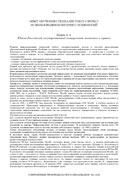PDF-версия статьи


|
The pace of the society in which we live requires more flexible ways of learning and adapted to changes. Formal, non formal, informal and invisible learning are living today in an expanded education and in a virtual space through the network. The Information and Communication Technologies are more than ever living in our society and they are important parts of the education. At Primary and Secondary Education, students start to use them in class, but the reality is that nowadays almost every student goes to school with a wide range of technological skills.
Schooling and teaching is changing with this new context. For example, students and teachers should have technological skills because they use them in their classroom and in their curricula. ICT have some characteristics that make them an essential tool in our daily life and for instance in our schools.
Also, it is very important to know that ICT are not only about computers and the internet, but also about a big amount of different tools such as mobile phone, tablets, etc. New Technologies have changed the way we communicate and the way we live and work. For this reason ICT in Education is an approach that makes the school and the society closer.
In this article we will focus on the role and different kinds of ICT in education and in the main characteristic that nowadays technologies have.
ICT are composted of many different tools that enable capturing, interpreting, storing and transmitting information in a fast and easy way. In the following figure (UNESCO, 2010), we can observe several options which allow us to better understand the society where we live:
This large number of tools makes our life easier and they are very helpful in organizing the big amount of information that we receive each day. We know that we do not use all of them everyday but also we know that students are in continuous contact with them and we cannot ignore it.
For this reason, the changing role of teachers is an essential issue. There is a need to move from a “push educator” to a “pull educator”. The first one fills the heads of their students with content without causing any activity or desire in them in order to deepen the knowledge and the potential of the resources around them. The second one awakes in students the motivation to learn and will help them in the sought of meaningful information that generates knowledge.
A good starting point, according to Anderson and van Weert (2002), is to join with fellow enthusiasts at the school, to meet together informally to talk about ICT issues and share knowledge. This process where two or more teaching colleagues work together to discuss problems, share experiences and provide support for one another with a view to improving their teaching is often called peer coaching.
References
1. Anderson, Jonathan. ICT transforming Education. A regional guide. Bangkok: UNESCO, 2010. Anderson, Jonathan. and van Weert, Tom. (Eds). 2002. Information and Communication Technology in Education: A Curriculum for Schools and Programme of Teacher Development. Paris, UNESCO. http://unesdoc.unesco.org/ images/0012/001295/129538e.pdf (Accessed 28 March, 2013)
2. Graham, Charles. R. Blended learning systems. Definition, current trends, and future directions. In C. J. Bonk. and C. R. Graham (Eds), The Handbook of Blended Learning: Global Perspectives, Local Designs (pp. 3-21). San Francisco, Pfeiffer, 2006.
ОПУБЛИКОВАНО
Mombekova S.S., Usenova A.Zh., Dzhusupbekova G.T., Shaymerdenova G.S., Kydirbekova A.S. ICT TRENDS IN EDUCATION. // Современные проблемы науки и образования - 2017.-№6. (приложение "Педагогические науки"). - C. 8